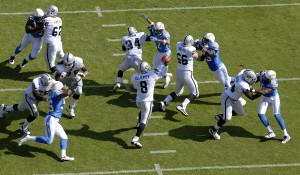The NFL concussion litigation is set to heat up again early next month, days before the regular season gets underway.
More than 4,000 former players are suing the league over claims the NFL hid known concussion risks, leading to high rates of dementia, depression and even suicides.
 Some believe the players’ claims could be worth $1 billion or more if they move forward in court. They range from the deaths of players like Junior Seau, Dave Duerson and lead plaintiff Ray Easterling to the medical care of players with disabling dementia to lifelong medical monitoring for those who are now symptom-free.
Some believe the players’ claims could be worth $1 billion or more if they move forward in court. They range from the deaths of players like Junior Seau, Dave Duerson and lead plaintiff Ray Easterling to the medical care of players with disabling dementia to lifelong medical monitoring for those who are now symptom-free.
Former Green Bay Packers running back Dorsey Levens, after oral arguments in the case in April, said he signed on to the litigation on behalf of “all the nameless, faceless guys that are suffering that you never heard of, … and people who have lost their lives, and the guys who are playing now, who are not really aware of the long-term ramifications of all these repeated head blows.”
Senior U.S. District Judge Anita Brody, of Philadelphia, had been ready to rule in July whether some or all of the players could pursue their claims in federal court. But she instead ordered the two sides to try to negotiate that issue and perhaps others, and report back to her by Sept. 3.
The season opens on Sept. 5 with Denver hosting Super Bowl champion Baltimore.
Sports law experts believe it’s too early to expect a settlement because the two sides have not yet begun discovery, when they take depositions and exchange evidence.
“I think it’s very unlikely that mediation will work at this stage,” said sports law professor Marc Edelman of Baruch College. “Often times in class action litigation, settlement occurs during or after the discovery.”
A gag order prevents either side from commenting on the negotiations, which are being led by federal judge-turned-mediator Layne Phillips of Newport Beach, California.
The NFL calls player safety a top priority, but insists that claims should be handled through league arbitration, in accord with the collective bargaining agreement.
The league has instituted safety measures that include rules changes designed to eliminate hits to the head and neck, protect defenseless players, and prevent concussed players from playing or practicing until they are fully recovered. Independent neurologists must be consulted before a player with a concussion can return to action.
A separate case involving the U.S. college sports governing body, the NCAA’s, concussion policies could have a ripple effect on the NFL talks. The NCAA, after lengthy discovery, agreed this month to try to settle the claims, which could involve tens of thousands of student-athletes.
In court papers, plaintiffs’ lawyers said they had unearthed damaging internal emails and other evidence that allegedly show the NCAA failed to adopt a uniform policy on when students should return to play after concussions.
“While the NCAA continues to believe these allegations are inappropriately made against the NCAA, we are willing to consider reasonable settlement options,” NCAA spokeswoman Stacey Osburn said in a statement this month.
If Brody allows even a single NFL lawsuit to proceed – such as one from a so-called “gap” player, who played when there was no collective bargaining agreement in place – the NFL could be forced to turn over a similar trove of internal documents about how it handled concussions over the past few decades, as scientific research emerged of a link between concussions and brain injuries.
“I think the NFL, players’ lawyers, and defense lawyers in the NFL litigation should certainly take note of what was uncovered in the NCAA players litigation,” said sports lawyer Paul Anderson of Kansas City, Mo., who runs a website devoted to the NFL concussion litigation.
If some see the NCAA case rattling the NFL, Edelman thinks it could cut the other way.
“One of the arguments that I would expect the NFL to make, in defending the concussion lawsuit, is that the players suffered their first or multiple concussions while under the supervision of the NCAA,” he said.
Either way, Brody clearly hoped to streamline the complex issues involved when she asked the two sides, however acrimonious, to sit down together. And Phillips, as a former judge, can suggest to them how he sees the case.
“That could move the parties close to settlement,” said Matt Mitten, director of the National Sports Law Institute at Marquette University.
He nonetheless sees the two concussion cases as more different than alike, given that the NFL players were professionals with a negotiated contract, while the NCAA’s stated mission is to protect student-athletes.
“The only way it might affect it is perhaps from a PR (public relations) … standpoint,” Mitten said. “If the NCAA settles, the public and others might say to the NFL … ‘Why don’t you settle, so that these players have the money to get the medical treatment that they need.”‘
Was this article valuable?
Here are more articles you may enjoy.


 Abbott Presses Congress for Shield Over Preemie Baby Formula Litigation That Could Cost It Billions
Abbott Presses Congress for Shield Over Preemie Baby Formula Litigation That Could Cost It Billions  Florida And East Coast Will See Big Losses From More Cat 5 Storms, Researchers Say
Florida And East Coast Will See Big Losses From More Cat 5 Storms, Researchers Say  Hermès Heir Sues Arnault and LVMH in $16 Billion Suit Over Lost Shares
Hermès Heir Sues Arnault and LVMH in $16 Billion Suit Over Lost Shares  Losses Top $20 Billion in Asia Floods as Climate Risks Grow
Losses Top $20 Billion in Asia Floods as Climate Risks Grow 